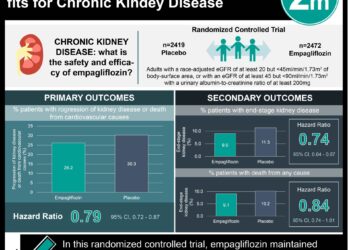Uric acid-lowering therapy not associated with improved kidney function
1. This retrospective cohort study demonstrated an increased risk of developing an estimated glomerular filtration rate (eGFR) less than 60 mL/min/1.73m2 and albuminuria after initiating uric acid-lowering therapy compared to those that did not begin therapy.
2. Uric acid levels less than or equal to 8 mg/dL were associated with an increased incidence of eGFR less than 60 mL/min/1.73m2, whereas levels above 8 mg/dL were not.
Evidence Rating Level: 2 (Good)
Study Rundown: Given the high prevalence of chronic kidney disease (CKD) worldwide, identifying modifiable risk factors has become a key area of research. Several studies have demonstrated an association between elevated urate levels and the progression of pre-existing CKD. However, decreased kidney function can lead to hyperuricemia, therefore, the causal link is not fully clear. Two trials examining CKD progression after initiating urate-lowering therapy demonstrated a lack of efficacy; however, whether lowering urate levels decreases the incidence of new-onset CKD is unknown. This retrospective cohort study investigated the association between uric acid levels and the incidence of chronic kidney disease using data from the TRI-CKD study that consists of a cohort of U.S veterans. Participants included had an estimated glomerular filtration rate (eGFR) of 60 mL/min/1.73m2 or greater and no albuminuria. The main exposure was the initiation of any chronic oral uric acid-lowering therapy. The co-primary outcomes were the incidences of new-onset eGFR less than 60 mL/min/1.73m2 and new-onset albuminuria. Data were collected from October 1, 2004, until September 30, 2006, with follow-up until September 30, 2019. The primary approach used a propensity score (PS) overlap weighting method. The initiation of chronic uric acid-lowering therapy was associated with significantly increased incidence of eGFR less than 60 mL/min/1.73m2 (subhazard ratio [SHR]: 1.15 [95% CI: 1.10-1.20]; p<0.001) and albuminuria (SHR: 1.05 [95% CI: 1.01-1.09]; p<0.001). The incidence of end-stage kidney disease was similar between those who did and did not initiate therapy (SHR: 0.96 [95% CI: 0.62-1.50]; p= 0.87). When assessing subgroup analyses, a uric acid level <8 mg/dL (SHR: 1.24 [95% CI: 1.18-1.31]) was associated with an increased incidence of eGFR less than 60 mL/min/1.73m2, but a uric acid level >8 mg/dL (SHR: 0.98 [95% CI: 0.91-1.06]) was not. Overall, this study demonstrated that uric acid-lowering therapy was not associated with renal-protective outcomes; conversely, it was associated with potentially harmful effects on kidney function. This study was limited by its cohort of only male veterans, which may not be generalizable to women or the remainder of the population.
Click to read the study in JAMA Network Open
Relevant Reading: Serum urate lowering with allopurinol and kidney function in type 1 diabetes
Image: PD
©2022 2 Minute Medicine, Inc. All rights reserved. No works may be reproduced without expressed written consent from 2 Minute Medicine, Inc. Inquire about licensing here. No article should be construed as medical advice and is not intended as such by the authors or by 2 Minute Medicine, Inc.






![The ABCD2 score: Risk of stroke after Transient Ischemic Attack (TIA) [Classics Series]](https://www.2minutemedicine.com/wp-content/uploads/2013/05/web-cover-classics-with-logo-medicine-BW-small-jpg-75x75.jpg)
